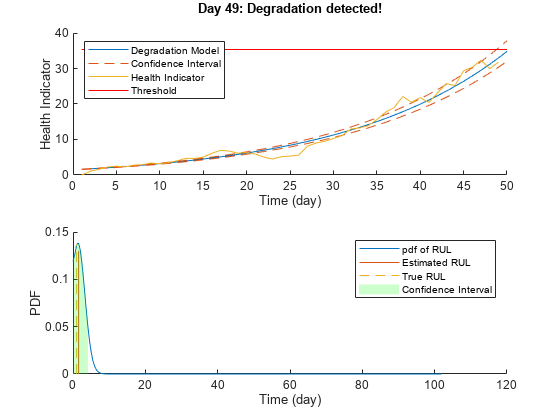Predict Remaining Useful Life (RUL)
One way of analyzing condition indicators is to use them in detecting faults, but you can also use a different type of condition-indicator analysis for predicting the RUL of a system. RUL of a machine is the expected life or usage time remaining before the machine requires repair or replacement.
Typically, you estimate the RUL of a system by developing a model that can perform the estimation based on the time evolution or statistical properties of condition indicator values. Predictions from such models are statistical estimates with associated uncertainty. They provide a probability distribution of the RUL of the test machine.
The model you use can be a dynamic model such as those you obtain using System Identification Toolbox™ commands. Predictive Maintenance Toolbox™ also includes some specialized models designed for computing RUL from different types of measured system data. For an overview of the types of models you can use, see Models for Predicting Remaining Useful Life.
Developing a model for RUL prediction is the next step in the algorithm-design process after identifying promising condition indicators. Because the model you develop uses the time evolution of condition indicator values to predict RUL, this step is often iterative with the step of identifying condition indicators.
Apps
| Health Indicator Designer | Interactively transform a set of features into a single composite health indicator that can be used to predict the remaining useful life (RUL) of a machine (Since R2024a) |
Functions
Topics
RUL Basics
- Models for Predicting Remaining Useful Life
You can use recursive models, identified models, or state estimators to predict remaining useful life (RUL). There are also specialized models designed for computing RUL from system data.
- Feature Selection for Remaining Useful Life Prediction
Rank features to determine best indicators of system degradation and improve accuracy of remaining useful life (RUL) predictions. - Perform Prognostic Feature Ranking for a Degrading System Using Diagnostic Feature Designer
This example shows how to segment data from a degrading system into frames, perform frame-based processing and feature extraction, and use prognostic ranking in Diagnostic Feature Designer.
Prediction Using RUL Models
- Update RUL Prediction as Data Arrives
This example shows how to update an RUL prediction as new data arrives from a machine under test. - Similarity-Based Remaining Useful Life Estimation
Build a complete Remaining Useful Life (RUL) estimation algorithm from preprocessing, selecting trendable features, constructing health indicator by sensor fusion, training similarity RUL estimators, and validating prognostics. - Wind Turbine High-Speed Bearing Prognosis
Build an exponential degradation model to predict the Remaining Useful Life (RUL) of a wind turbine bearing in real time. The exponential degradation model predicts the RUL based on its parameter priors and the latest measurements. - Live RUL Estimation of a Servo Gear Train Using ThingSpeak
This example shows how to estimate the Remaining Useful Life (RUL) of a servo motor gear train through real-time streaming of servo motor data from an Arduino-based data acquisition system to ThingSpeak™, and from ThingSpeak to an RUL estimation engine running in MATLAB®. - ThingSpeak Dashboard for Live RUL Estimation of a Servo Motor Gear Train
This example shows how to set up a ThingSpeak™ dashboard to estimate and visualize the Remaining Useful Life (RUL) of a servo motor gear train.
Prediction Using Identified Models or State Estimators
- Nonlinear State Estimation of a Degrading Battery System
Estimate the states of a nonlinear system using an unscented Kalman filter in Simulink. - Condition Monitoring and Prognostics Using Vibration Signals
Extract features from vibration signals from a ball bearing, conduct health monitoring, and perform prognostics.
Prediction Using Artificial Intelligence
- Battery Cycle Life Prediction from Initial Operation Data
Predict the remaining cycle-life of a fast charging Li-ion battery using a supervised machine learning algorithm. - Fault Detection and Remaining Useful Life Estimation Using Categorical Data
Use categorical data to improve the accuracy of machine fault predictions. - Remaining Useful Life Estimation Using Convolutional Neural Network
This example shows how to predict the RUL of engines using deep convolutional neural networks (CNN). - Battery Cycle Life Prediction Using Deep Learning
Predict the remaining cycle-life of a fast charging Li-ion battery by training a deep neural network.

